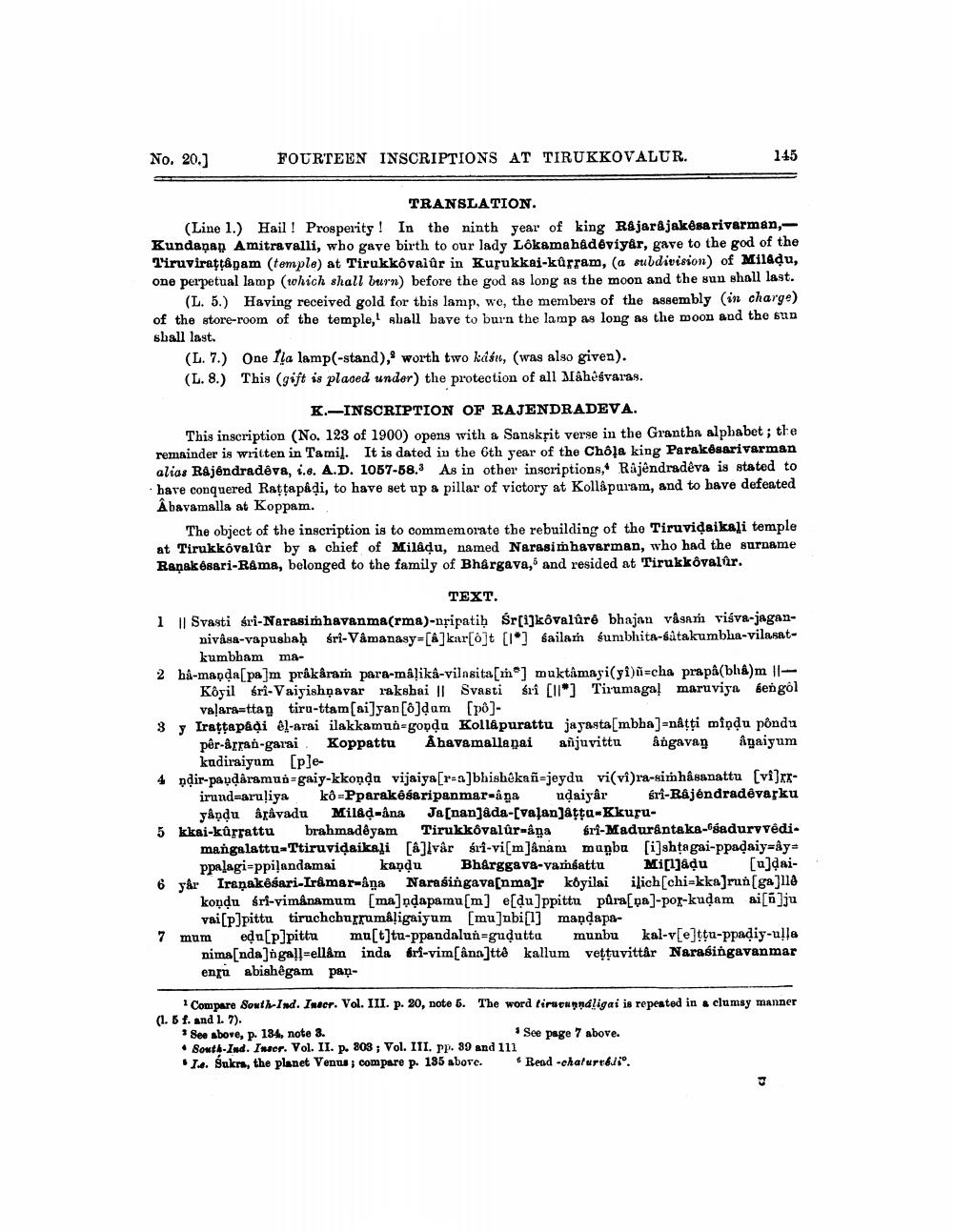________________
No. 20.)
FOURTEEN INSCRIPTIONS AT TIRUKKOVALUR.
145
TRANSLATION. (Line 1.) Hail ! Prosperity! In the ninth year of king Rajarajakesarivarman, Kundaņap Amitravalli, who gave birth to our lady Lôkamahadeviyar, gave to the god of the Tiruvirattåpam (temple) at Tirukkôvaiûr in Kurukkaj-kúrram, (a suldivision) of Miladu, one perpetual lamp which shall burn) before the god as long as the moon and the sun shall last.
(L. 5.) Having received gold for this lamp, we, the members of the assembly (in charge) of the store-room of the temple, sball bave to burn the lamp as long as the moon and the sun sball last.
(L. 7.) One fla lamp(-stand), worth two kasu, (was also given). (L. 8.) This (gift is placed under) the protection of all Mahesvaras.
K-INSCRIPTION OF RAJENDRADEVA. This inscription (No. 123 of 1900) opens with a Sanskrit verse in the Grantha alphabet; the remainder is written in Tamil. It is dated in the 6th year of the Chola king Parakesarivarman alias Rajendradêva, 1.6. A.D. 1057-58. As in other inscriptions, Rajendradeva is stated to have conquered Rattapadi, to have set up a pillar of victory at Kollapuram, and to have defeated Âbavamalla at Koppam.
The object of the inscription is to commemorate the rebuilding of the Tiruvidaikali temple at Tirukkovalur by a chief of Miladu, named Narasimhavarman, who had the surname Ranak @sari-Rama, belonged to the family of Bhargava, and resided at Tirukkovalûr.
TEXT. 1 || Svasti sri-Narasimhavanma(rma)-nfipatiḥ śr[i]kôvaluró bhajan vâsan visva-jagan
nivasa-vapushah sri-Vamanasy=[6]kar[ôjt (1) sailar gumbhita-satakumbha-vilasat
kumbham ma2 hå-mapda[pa]m prákaram para-maļika-vilasita[m] muktamayi(yi)i=cha prapa(bhá)m ||
Koyil sri-Vaiyishộavar raksbai || Svasti sri [ll") Tirumaga! maruviya bengol
Valara=ttan tiru-ttam(ai]yan[o]dam (po)3 y Iraţtapaļi el-arai ilakkamun=goodu Kollâpurattu jayasta[mbba)=nåtti miņdu pôndu
pêr-arran-garai. Koppattu Åhavamallaņai anjuvittu ärgavaŋågaiyum
kadiraiyam [ple4 pdir-paudaramur-gaiy-kkondu vijaiya[r-a]bhishekanajeydu vi(vi)ra-simhâsanattu (vi)rt
irund=aruliya kô Pparakesaripanmar-aga udaiyâr ri-Rajendradevasku
yåpdu Agávadu Milad-ina Jasnanjada-[valanjattu-Kkuru5 kkai-kûrrattu brahmadêyam Tirukkôvalûr-åņa $ri-Madurântaka-sadurvvédi.
mangalattu-Ttiruvidaikaji [&] vår sri-vi[m]&nam mupbu [i]shtagai-ppadaiy=&y=
ppalagi=ppilandamai kandu Bhârggava-vansattu Miljadu [u]dai6 yår Iraņakeśari-Iramar-åņa Narasingava[nma]r koyilai ilich[chi-kka]run[ga]118
kondu sri-vimânamum [ma]ndapamu[m] e[du]ppittu pūra[pa)-por-kudam ai[6]ju
vai[p]pittu tiruchchurrum&ligaiyum [mu]ubi[l] mapdapa7 mum edu[p]pittu mu[t]tu-ppandalun-gudutta munbu kal-v[e]ttu-ppadiy-u!la
nime[ndaliga!]=ellam inda fri-vim[âna]tte kallum vettuvittår Narasingavanmar enga abishêgam pan
clumsy manner
Compare South-Ind. Inacr. Vol. III. p. 20, note 5. The word firacugnaligai is repeated in (1. 6 f. and 1. 7). * See above, p. 184, note 8.
See page 7 above. • South-Ind. Inser. Vol. II. p. 808 ; Vol. III. pp. 89 and 111
1... Sukra, the planet Ventuscompare p. 135 above. Read -chalure&lio




